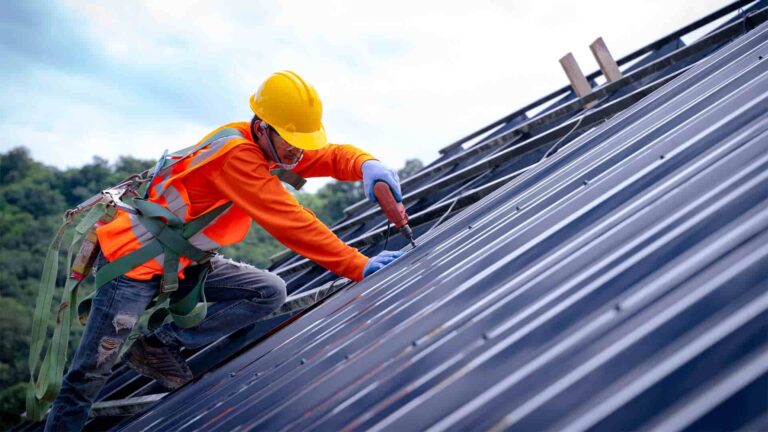I’m so glad you stopped by today. Maybe you’re sitting there looking up at some water stains on your ceiling, or you noticed a few shingles in your yard after that big storm last week. Whatever brought you here, planning for roof repairs can feel like a real head-scratcher if you’ve never done it before.
I’ve been in the roofing business longer than I care to admit, and let me tell you – a little planning goes a long way when it comes to fixing up what’s over your head.
Your roof is literally your home’s umbrella, keeping everything you love safe and dry. When it needs fixing, you don’t want to just wing it.
The good news? I’m gonna walk you through exactly how to plan for your roof repair, step by step, no fancy jargon, just practical advice that’ll save you time, money, and a whole lot of headaches.
So grab a cup of coffee, get comfortable, and let’s talk about how to get that roof of yours back in tip-top shape!
10 Tips For Roofing Reparing By Experts
Before we dive into the nitty-gritty, let’s talk about what makes a roof repair successful. It’s not just about slapping on some new shingles and calling it a day.
The secret sauce is in the planning – knowing what needs fixing, finding the right people for the job, understanding the timeline, and being prepared for everything in between.
These next 10 tips come from years of seeing what works and what leads to those “I wish someone had told me” moments.
Whether you’re dealing with a tiny leak or thinking about a bigger repair job, these tips will help you navigate the process like a pro.
And trust me, knowing where to find roof repair in Phoenix or wherever you call home is just one piece of the puzzle – there’s so much more to getting it right!
Inspect the Roof Thoroughly First
First things first – you gotta know what you’re dealing with before you start calling contractors.
Get yourself a good pair of binoculars and do a ground inspection of your roof. Look for missing shingles, curled edges, or any spots that just look worn out.
If you’re comfortable climbing a ladder, take a closer look at your gutters too. They full of little granules that look like sand? That’s a sign your shingles are wearing out.
Water stains on your ceiling are huge red flags. Follow them up to the attic if you can. Sometimes what looks like a roof leak is actually a plumbing or ventilation issue.
Take pictures of everything that doesn’t look right. These will come in super handy when you’re talking to contractors later.
And hey, if you’re not sure what you’re looking at, don’t worry! Most roofing companies offer free inspections. They’ll spot things you might miss, like damage around vents or flashing that’s pulling away.
The better you understand what needs fixing, the more accurate your plan – and your budget – will be.
Determine the Scope of Repair
Once you’ve got a good look at your roof, it’s time to figure out if you need a quick patch job or something more serious.
Sometimes what looks like a small problem on the surface can actually be a sign of bigger issues underneath. That single leak could mean your roof decking is getting soggy.
Ask yourself these questions: How old is your roof? If it’s pushing 20+ years, repairs might just be a band-aid. How many problem areas did you find? Multiple issues across the roof usually signal it’s time for more than just a repair.
Don’t forget to check inside your attic for signs of water damage or daylight peeking through. Those are clear signals that water’s been getting in for a while.
I once had a customer who just wanted to fix a small leak, but when we looked closer, we found out the underlayment was shot in multiple places. Fixing just the one spot would’ve been throwing good money after bad.
Be honest with yourself about what your roof really needs. Sometimes a repair is perfect, but other times, it’s smarter to put that money toward a replacement instead.
Set a Realistic Budget
Let’s talk money – nobody’s favorite topic, but super important when it comes to roof repairs.
A good rule of thumb? Minor repairs might run you a few hundred dollars, while bigger jobs could climb into the thousands, depending on your roof size and what materials you need.
Don’t just grab a number out of thin air. Do some homework on what roofing costs in your area. For example, simply search online, such “HOF Roofing in Cleveland” and you may find their pricing online.
Prices can vary a ton based on where you live and current material costs.
Always add a cushion of about 10-20% to whatever estimate you get. I can’t tell you how many times we’ve pulled off some shingles only to find rotten wood underneath that also needed replacing.
If your budget’s tight, ask contractors if they offer financing options. Many do these days, and some even have zero-interest plans if you qualify.
Remember, the cheapest bid isn’t always the best deal. Super low estimates often mean corners will be cut somewhere, and that’ll cost you more down the road.
The goal isn’t to spend as little as possible – it’s to get the job done right the first time at a fair price.
Choose the Right Roofing Materials
Picking materials contrast isn’t just about what looks pretty – it’s about what works for your climate, your home, and your wallet.
Asphalt shingles are the most common choice, and for good reason. They’re affordable and work well in most climates. But if you live somewhere with extreme weather, you might want to look at impact-resistant shingles.
Metal roofing costs more upfront but can last twice as long as asphalt. Plus, it’s great for shedding snow and reflecting heat in hot summers.
Tile and slate are beautiful and super durable, but they’re heavy rain. Your house might need extra structural support to handle them, which adds to the cost.
Don’t forget about color! Darker roofs absorb more heat, which might increase your cooling bills if you live in a hot area.
Ask your contractor to show you actual samples, not just pictures. What looks good online might look totally different on your actual house.
And hey, if sustainability matters to you, there are eco-friendly options made from recycled materials that look great and perform well too.
The right material makes all the difference between a repair that lasts 5 years and one that lasts 25.
Hire a Qualified Roofing Contractor
Finding a good roofer is probably the most important decision you’ll make in this whole process.
Start by asking neighbors or friends who’ve had roof work done. Nothing beats a personal recommendation from someone who’s already seen the work firsthand.
Always check for proper licensing and insurance. A legitimate contractor should have liability insurance and workers’ comp for their crew. Ask to see certificates and actually call to verify them.
Look at online reviews, but read between the lines. One bad review amid dozens of good ones might be a fluke, but patterns of complaints about the same issues? That’s a red flag.
Get at least three estimates, and be suspicious if one is way lower than the others. Compare what each contractor is actually proposing – are they addressing the same issues? Using the same materials?
Ask about crew experience and whether they use subcontractors. The contractor might be great, but you want to know who’s actually climbing on your roof.
Never pay the full amount upfront. A reasonable deposit is normal, but full payment should happen only when you’re satisfied with the completed work.
Trust your gut feeling when meeting contractors. If someone makes you uncomfortable or pressures you for a quick decision, keep looking.
Check for Permits and Regulations
This might sound boring, but skipping permits can come back to bite you later, especially if you ever sell your house.
Most areas require permits for roof work beyond simple repairs. Your contractor should handle pulling permits, but it’s your responsibility to make sure it happens.
Some neighborhoods have homeowner associations with rules about roofing materials and colors. Check your HOA guidelines before you get too far into planning.
If you live in a historic district, there might be extra regulations about maintaining the home’s original look. These rules can limit your material choices.
Insurance companies sometimes offer discounts for certain types of roofing in storm-prone areas. Check if your planned repair qualifies for any breaks on your premium.
Some states have specific requirements for roofing in wildfire zones or hurricane regions. These special codes might affect your material choices and installation methods.
Your contractor should know local codes, but don’t just assume. A quick call to your local building department can save major headaches down the road.
Doing things by the book might take a little extra time, but it protects you legally and financially.
Plan Around Weather Conditions
Timing is everything when it comes to roof repairs, and Mother Nature gets a big vote in the schedule.
The ideal roofing season varies depending on where you live. In most places, late spring through early fall offers the most reliable weather.
Try to schedule your repairs during a stretch when the forecast shows several dry days in a row. Most contractors need at least 2-3 consecutive days without rain.
Extreme temperatures can affect roofing materials. Shingles can crack if installed when it’s too cold, and they can get soft and damage easily when it’s too hot.
Have a backup plan for unexpected weather delays. Your contractor should include weather contingencies in the contract, spelling out what happens if work gets rained out.
If you’re dealing with an active leak and can’t wait for perfect weather, ask about temporary patching options to protect your home until full repairs can be made.
Smart contractors will tarp unfinished sections at the end of each workday, just in case surprise showers pop up overnight.
Remember, good roofers get booked up fast during prime roofing season. Plan ahead if you want your first-choice contractor during the best weather months.
Prepare Your Home and Family
Roof repairs can turn your home upside down for a bit, so a little prep work goes a long way.
Clear your driveway and the areas around your house. The crew will need space for trucks, materials, and that big dumpster for old roofing.
Inside your home, remove fragile items from walls and shelves. The hammering and foot traffic on your roof can cause vibrations that knock things over.
If you have pets, plan for their safety and comfort house. The noise can stress them out, and you don’t want them running out an open gate when workers are coming and going.
Cover items in your attic with plastic sheets. Even with care, dust and debris can filter down during the work.
Temporarily relocate sensitive electronics if possible. All that pounding can sometimes affect satellite dishes and antennas.
Let your neighbors know about the upcoming work. It’s a courtesy that goes a long way, especially since they’ll be dealing with some noise too.
If you work from home, you might want to find an alternative workspace during the noisiest parts of the project. Those Zoom calls won’t be fun with roofers overhead!
A little preparation makes the whole process smoother for everyone – you, your family, and the roofing crew.
Understand the Repair Timeline
Knowing what to expect timing-wise helps keep your stress levels down during the project.
Most basic roof repairs take 1-3 days, but more extensive work can stretch to a week or more, depending on your roof size and complexity.
The process usually starts with removing damaged materials, which is often the noisiest part. Next comes any needed deck repairs, then new underlayment and finally the new roofing material.
Weather can throw even the best timeline off track. Build in some buffer days when planning around important events at your home.
Material availability can affect scheduling too. Supply chain issues have been a real headache lately, so ask your contractor if all materials are already in stock.
Unexpected problems like hidden water damage or rotted decking can extend the timeline. Your contractor should communicate these discoveries promptly if they happen.
The final cleanup should be included in your contractor’s timeline estimate. A good crew won’t consider the job done until all nails and debris are cleared from your property renovation.
Ask for a written schedule before work begins, and have your contractor explain each phase so you know what to expect day by day.
Ask About Warranties and Maintenance
The repair is done, but your roofing journey isn’t over yet – now it’s all about protecting your investment.
Make sure you understand both the manufacturer’s warranty on materials and your contractor’s warranty on workmanship. They’re two different things!
Get warranty information in writing, and store it somewhere safe. Digital copies are great, but have a paper backup too.
Ask what might void your warranty. Some require professional maintenance checks, while others can be voided by certain home modifications.
Create a simple maintenance schedule based on your contractor’s recommendations. Most roofs benefit from a visual inspection at least once a year.
Find out if your contractor offers maintenance programs. Some provide annual inspections at reduced rates for previous customers.
Understand what normal aging looks like for your new materials versus signs of a problem. Knowing the difference helps you spot warranty issues early.
Keep records of all maintenance and additional work done on your roof. These can be important if you ever need to make a warranty claim.
Remember, even the best roof repair needs some TLC to reach its full lifespan potential. A little attention each year saves a lot of money in the long run.
Conclusion
Whew! We covered a lot of ground today, didn’t we? Planning for roof repairs might seem like a mountain of work at first glance, but breaking it down into these steps makes it totally manageable.
Remember, your roof is way too important to cut corners on. It protects everything underneath it – your family, your belongings, your memories.
Taking the time to inspect thoroughly, set a realistic budget, find the right materials and contractor, check regulations, plan for weather, prepare your home, understand the timeline, and get solid warranty information – it all pays off in a repair that lasts.
The best roof repairs are the ones you don’t have to think about again for a very long time. That peace of mind is worth every bit of planning effort.
So take a deep breath, use these tips as your roadmap, and tackle that roof repair with confidence. Your future self will thank you when the next big storm rolls through and you’re sitting dry and cozy inside!
Got questions I didn’t cover? Reach out anytime. There’s nothing I love more than helping folks protect their homes with solid, reliable roofs over their heads.
Happy roofing, friends!



